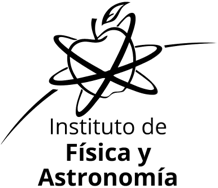Theoretical physics
Researchers
- Graeme Candlish: Cosmology, gravitation, galaxy evolution, numerical simulations.
- Iván González: High-energy physics, perturbative calculations, Feynman diagrams.
- Víctor Cárdenas: Cosmology, dark matter, dark energy, inflation.
- Alfredo Vega: High-energy physics, particle theory.
- José Villanueva: Cosmology, inflation, dark energy, gravitation, modified gravity theories.
- Marcela González: Particle physics, physics beyond the standard model, leptonic violation, and effective theories.
- Cristian Barrera: Cosmology, gravitation, numerical simulation and scientific computing.
Areas of research
The theoretical physics group of the Institute of Physics and Astronomy at the Universidad de Valparaíso does research in several areas, ranging from the very small – as in the study of elementary particles – to the largest scales imagined – as is given in the study of theories of gravitation and cosmology. These complement each other, since its members work on converging themes, besides being related to astrophysics. In our institute, various topics are discussed in the following areas:
Cosmology
Cosmology is a rapidly developing area linking aspects of theories of gravitation, particle physics, and astrophysics. The discovery of the accelerating universe expansion and the successful detection of anisotropy and polarisation in the cosmic background radiation implies a universe where almost 96% of its content is unknown. We know that most dark matter is non-baryonic and that dark energy fills the universe to the largest observed scales. In this group, we study topics in theoretical cosmology, both at early times (inflation, reheating) and later epochs (dark matter and dark energy-dominated eras). We also study the constraints on alternative cosmological models, using information from galaxy clusters as observational probes, such as gravitational lensing, X-ray emission, Sunyaev-Zeldovich effect, etc. Victor Cardenas and Jose Villanueva develop theoretical models for dark matter and dark energy, testing them against a diverse set of observational data to help us better understand the features of these dark components.
Particle physics
Particle Physics aims to describe natural phenomena, considering the fundamental constituents of matter and its interactions. To date, matter is made up of quarks (that, for example, exist inside protons and neutrons) and leptons (like electrons). Said particles form different structures present in our Universe by their varied interactions. On the other side, according to our actual knowledge, the fundamental interactions responsible for all physical phenomena are four: gravity, electromagnetism, and weak and strong interactions.
Our Institute’s research on Particle Physics focuses on two big topics. For one side, we work on developing mathematical techniques to evaluate Feynman diagrams at high order, which are usual tools in any perturbative calculation used to study processes involving subatomic particles. Conversely, our group works in hadronic physics in the non-perturbative region using different phenomenological methods, especially those based on Gauge / Gravity dualities in the Bottom-Up approach and using Light Front Holography.

